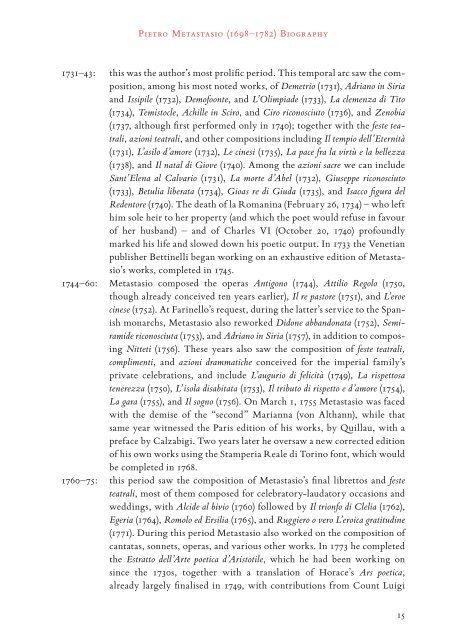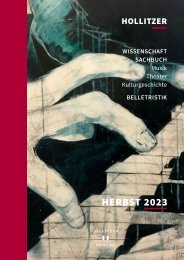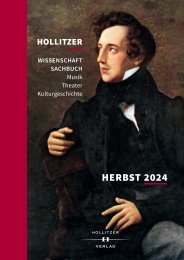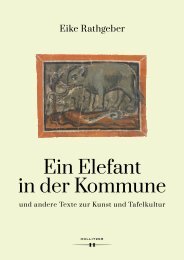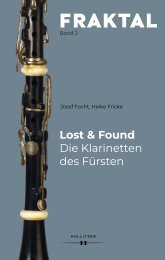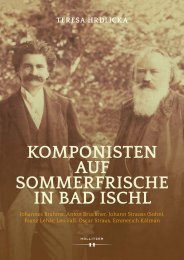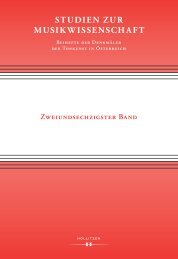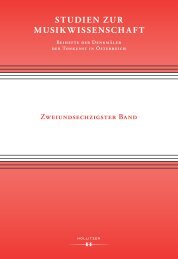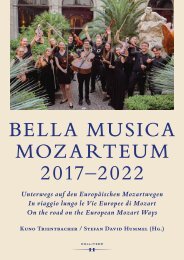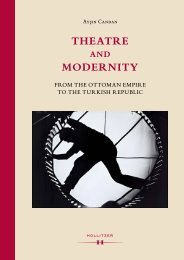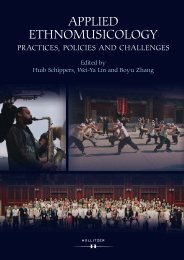Create successful ePaper yourself
Turn your PDF publications into a flip-book with our unique Google optimized e-Paper software.
Pietro <strong>Metastasio</strong> (1698–1782) Biography<br />
1731–43: this was the author’s most prolific period. This temporal arc saw the composition,<br />
among his most noted works, of Demetrio (1731), Adriano in Siria<br />
and Issipile (1732), Demofoonte, and L’Olimpiade (1733), La clemenza di Tito<br />
(1734), Temistocle, Achille in Sciro, and Ciro riconosciuto (1736), and Zenobia<br />
(1737, although first performed only in 1740); together with the feste teatrali,<br />
azioni teatrali, and other compositions including Il tempio dell’Eternità<br />
(1731), L’asilo d’amore (1732), Le cinesi (1735), La pace fra la virtù e la bellezza<br />
(1738), and Il natal di Giove (1740). Among the azioni sacre we can include<br />
Sant’Elena al Calvario (1731), La morte d’Abel (1732), Giuseppe riconosciuto<br />
(1733), Betulia liberata (1734), Gioas re di Giuda (1735), and Isacco figura del<br />
Redentore (1740). The death of la Romanina (February 26, 1734) – who left<br />
him sole heir to her property (and which the poet would refuse in favour<br />
of her husband) – and of Charles VI (October 20, 1740) profoundly<br />
marked his life and slowed down his poetic output. In 1733 the Venetian<br />
publisher Bettinelli began working on an exhaustive edition of <strong>Metastasio</strong>’s<br />
works, completed in 1745.<br />
1744–60: <strong>Metastasio</strong> composed the operas Antigono (1744), Attilio Regolo (1750,<br />
though already conceived ten years earlier), Il re pastore (1751), and L’eroe<br />
cinese (1752). At Farinello’s request, during the latter’s service to the Spanish<br />
monarchs, <strong>Metastasio</strong> also reworked Didone abbandonata (1752), Semiramide<br />
riconosciuta (1753), and Adriano in Siria (1757), in addition to composing<br />
Nitteti (1756). These years also saw the composition of feste teatrali,<br />
complimenti, and azioni drammatiche conceived for the imperial family’s<br />
private celebrations, and include L’augurio di felicità (1749), La rispettosa<br />
tenerezza (1750), L’isola disabitata (1753), Il tributo di rispetto e d’amore (1754),<br />
La gara (1755), and Il sogno (1756). On March 1, 1755 <strong>Metastasio</strong> was faced<br />
with the demise of the “second” Marianna (von Althann), while that<br />
same year witnessed the Paris edition of his works, by Quillau, with a<br />
preface by Calzabigi. Two years later he oversaw a new corrected edition<br />
of his own works using the Stamperia Reale di Torino font, which would<br />
be completed in 1768.<br />
1760–75: this period saw the composition of <strong>Metastasio</strong>’s final librettos and feste<br />
teatrali, most of them composed for celebratory-laudatory occasions and<br />
weddings, with Alcide al bivio (1760) followed by Il trionfo di Clelia (1762),<br />
Egeria (1764), Romolo ed Ersilia (1765), and Ruggiero o vero L’eroica gratitudine<br />
(1771). During this period <strong>Metastasio</strong> also worked on the composition of<br />
cantatas, sonnets, operas, and various other works. In 1773 he completed<br />
the Estratto dell’Arte poetica d’Aristotile, which he had been working on<br />
since the 1730s, together with a translation of Horace’s Ars poetica,<br />
already largely finalised in 1749, with contributions from Count Luigi<br />
15


